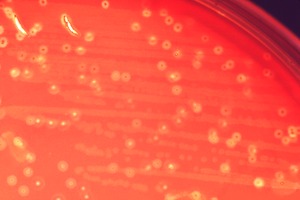Streptococcus anginosus

Streptococcus anginosus is a species of Gram-positive bacteria that is part of the Streptococcus anginosus group (SAG), also known as the "milleri group." This group, which also includes Streptococcus constellatus and Streptococcus intermedius, is distinguished by its ability to cause a variety of purulent infections in humans. Streptococcus anginosus itself is often found in the mouth, throat, digestive tract, and urogenital tract of humans, living as a commensal organism without causing disease under normal circumstances. However, when the body's normal barriers are breached, it can become pathogenic, leading to infections that are sometimes severe.
Characteristics[edit]
Streptococcus anginosus is a non-motile, facultatively anaerobic organism that forms small, round colonies on blood agar. It is capable of producing a narrow zone of beta-hemolysis when cultured on blood agar plates, although this characteristic can vary among strains. The bacteria are known for their ability to ferment various carbohydrates, producing lactic acid as a byproduct, and for their production of volatile sulfur compounds that can contribute to bad breath.
Pathogenicity[edit]
The pathogenic potential of Streptococcus anginosus is significant, particularly because it can cause deep-seated abscesses and systemic infections. It has been implicated in a variety of clinical conditions including brain abscesses, liver abscesses, endocarditis, dental infections, and soft tissue infections. The ability of S. anginosus to cause disease is partly attributed to its production of enzymes such as hyaluronidase, which facilitates the spread of infection through tissues. Additionally, its ability to form biofilms on surfaces, including medical devices, contributes to its pathogenicity and complicates treatment.
Clinical Significance[edit]
The clinical significance of Streptococcus anginosus lies in its ability to cause invasive infections that can be difficult to diagnose and treat. Its presence in abscesses is particularly noteworthy, as it can be an indicator of a mixed infection involving anaerobic bacteria. The diagnosis of S. anginosus infections involves culture of the organism from clinical specimens, followed by biochemical and molecular identification. Treatment typically involves the use of antibiotics, with the choice of antibiotic depending on the sensitivity profile of the isolate and the site of infection. Surgical intervention may be required in cases of abscess formation.
Prevention and Control[edit]
Prevention of infections caused by Streptococcus anginosus involves general measures to maintain the integrity of the skin and mucosal barriers, as well as good oral hygiene to reduce the bacterial load in the mouth. In healthcare settings, adherence to infection control practices is crucial to prevent the transmission of S. anginosus and other pathogens.
-
Streptococcus anginosus
Ad. Transform your life with W8MD's Budget GLP-1 injections from $75


W8MD offers a medical weight loss program to lose weight in Philadelphia. Our physician-supervised medical weight loss provides:
- Weight loss injections in NYC (generic and brand names):
- Zepbound / Mounjaro, Wegovy / Ozempic, Saxenda
- Most insurances accepted or discounted self-pay rates. We will obtain insurance prior authorizations if needed.
- Generic GLP1 weight loss injections from $75 for the starting dose.
- Also offer prescription weight loss medications including Phentermine, Qsymia, Diethylpropion, Contrave etc.
NYC weight loss doctor appointmentsNYC weight loss doctor appointments
Start your NYC weight loss journey today at our NYC medical weight loss and Philadelphia medical weight loss clinics.
- Call 718-946-5500 to lose weight in NYC or for medical weight loss in Philadelphia 215-676-2334.
- Tags:NYC medical weight loss, Philadelphia lose weight Zepbound NYC, Budget GLP1 weight loss injections, Wegovy Philadelphia, Wegovy NYC, Philadelphia medical weight loss, Brookly weight loss and Wegovy NYC
|
WikiMD's Wellness Encyclopedia |
| Let Food Be Thy Medicine Medicine Thy Food - Hippocrates |
Medical Disclaimer: WikiMD is not a substitute for professional medical advice. The information on WikiMD is provided as an information resource only, may be incorrect, outdated or misleading, and is not to be used or relied on for any diagnostic or treatment purposes. Please consult your health care provider before making any healthcare decisions or for guidance about a specific medical condition. WikiMD expressly disclaims responsibility, and shall have no liability, for any damages, loss, injury, or liability whatsoever suffered as a result of your reliance on the information contained in this site. By visiting this site you agree to the foregoing terms and conditions, which may from time to time be changed or supplemented by WikiMD. If you do not agree to the foregoing terms and conditions, you should not enter or use this site. See full disclaimer.
Credits:Most images are courtesy of Wikimedia commons, and templates, categories Wikipedia, licensed under CC BY SA or similar.
Translate this page: - East Asian
中文,
日本,
한국어,
South Asian
हिन्दी,
தமிழ்,
తెలుగు,
Urdu,
ಕನ್ನಡ,
Southeast Asian
Indonesian,
Vietnamese,
Thai,
မြန်မာဘာသာ,
বাংলা
European
español,
Deutsch,
français,
Greek,
português do Brasil,
polski,
română,
русский,
Nederlands,
norsk,
svenska,
suomi,
Italian
Middle Eastern & African
عربى,
Turkish,
Persian,
Hebrew,
Afrikaans,
isiZulu,
Kiswahili,
Other
Bulgarian,
Hungarian,
Czech,
Swedish,
മലയാളം,
मराठी,
ਪੰਜਾਬੀ,
ગુજરાતી,
Portuguese,
Ukrainian

